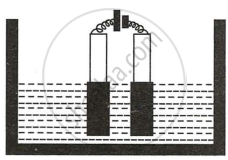Advertisements
Advertisements
Question
A strip of copper is placed in four different colourless salt solutions. They are KNO3, AgNO3, Zn(NO3)2 and Ca(NO3)2. Which one of the solutions will finally turn blue?
Solution
AgNO3 solution will turn blue.
APPEARS IN
RELATED QUESTIONS
Complete the following by selecting the correct option from the choices given:
The divalent metal whose oxide is reduced to metal by electrolysis of its fused salt is __________. (Al/Na/Mg/K)
State your observation for the following electrolytic reaction
Aqueous copper sulphate is electrolysed between copper electrodes.
What kind of particles will be found in a liquid compound which is a non- electrolyte?
Three different electrolytic cells, A, B and C are connected in separate circuits. Electrolytic cell A contains a sodium chloride solution. When the circuit is completed, a bulb in the circuit glows brightly. Electrolytic cell B contains an acetic acid solution and in this case, the bulb in the circuit glows dimly. The electrolytic cell C contains a sugar solution and the bulb does not glow. Give a reason for each of these observations.
Differentiate between the electrical conductivity of copper sulphate solution and copper metal.
Copper sulphate solution is electrolyzed using copper electrodes. Study the diagram given alongside and answer the questions that follow.

- Which electrode to your left or right is known as the oxidizing electrode and why?
- Write the equation representing the reaction that occurs.
- State two appropriate observations for the above electrolysis reactions.
Give appropriate scientific reasons for the following statement :
Electrolysis of molten lead bromide is considered to be a redox reaction.
Select the ion, that would get selectively discharge from the aqueous mixture of the ions listed below :
\[\ce{SO^{2-}_{4}}\], \[\ce{NO^{-}_{3}}\], \[\ce{OH-}\]
From the following list of substances choose those which meet the description given below.
Ammonium chloride, ammonium nitrate, chlorine, dilute hydrochloric acid, iron, lead nitrate, manganese (IV) oxide, silver nitrate, sodium nitrate, sodium nitrite, and sulphur.
Two compounds whose aqueous solutions give white precipitates with dilute hydrochloric acid.
Classify the following substance:
Dilute hydrochloric acid
